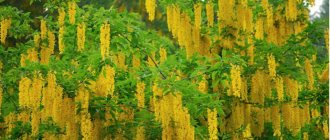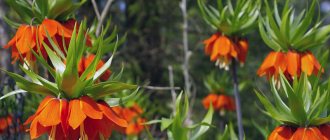Decorative sunflower
The decorative sunflower differs from the agricultural crop we are familiar with not only in the size of its bright, sunny flowers, but also in its purpose, the main goal of which is to create a unique rustic (country) style flavor in the garden.
By the way, for the first time, sunflower seeds (Helianthus, from the Greek “helios” - “sun” and “anthos” - “flower”) were brought from Mexico in 1510 by members of the fourth expedition of Christopher Columbus. Once in Europe, the sunflower became a universal favorite, arousing genuine interest and admiration. For centuries, songs and poems have been written about him, and his image is depicted in paintings by famous artists. Thus, it is the decorative sunflower that is depicted in the famous series of Van Gogh’s “Sunflowers” paintings.
Vincent Van Gogh. "Sunflowers". Photo from pixabay.com
Thanks to the continuous work of breeders, armed with modern methods of biotechnology and genetics, over 150 new varieties and hybrids of ornamental sunflower have been created. Every year new products appear on the market, each of which is a new word in the selection of the species. Already released:
- touching miniature sunflowers that can simultaneously bear several flowers on one stem;
- charming double sunflowers with a dense orange-brown core;
- sunflowers similar to marigolds;
- many decorative varieties with extraordinary colors - from cream to peach-pink.
Ads by
Description of decorative sunflower
Most Sunflowers are annuals. They germinate in late spring, bloom in summer and die off with the first autumn frosts. “Sunny Flower” has a wide variation in types and sizes. The petals can be simple or terry in shape, and there are various configuration variations - wavy, curved, twisted. The height of the plant can reach up to 5 meters, but there are also low-growing varieties - up to 0.3 meters.
The flowers are huge, up to 0.5 meters in diameter. No more than 1-10 voluminous inflorescences are formed on one stem. The decorative sunflower begins to bloom in July-August and continues to delight with fiery petals until late autumn.
What is a flower
Limnanthes is an annual plant, a member of the Limnanthaceae family. Its main species is called Limnanthes Douglas, named after the famous Scottish “plant hunter” David Douglas, who enriched the European flora with two hundred hitherto unknown species and died on his next expedition at the age of 35.
The height of the plant is from 20 to 30 cm. The stems are erect, but can also take a “lying position”, as they branch heavily. This allows Limnanthes to serve as a ground cover crop. Most of these plants are attractive for their beautiful foliage, but Limnanthes has flowers in the foreground. Small, 3 cm in diameter, they appear on the stems in such numbers that sometimes they completely cover the foliage. In this case, each individual bush can occupy a conventional circle with a diameter of 45 square meters. cm.
The flowers have 5 petals, exuding a sweet aroma that haunts butterflies and bees. The traditional color is like that of a fried egg, but there are varieties that are exclusively yellow or white, less often pink or in the form of different shades of strokes. The first buds bloom in June, flowering ends in late autumn. The leaves are lacy-pinnate, light green. The seeds ripen in August. Limnantes is not afraid of light frosts, down to -3°C.
Despite the fact that the name of the flower clearly indicates its commitment to moisture, it does not at all like to grow in swampy soil. In nature, limnanthes is found in mountain valleys, where high humidity is typical for winter and early spring, but the growing season of the flower always falls in dry months with rare rainfall, and these conditions suit it quite well. Therefore, it would be a mistake to allocate places for Limnanthes in a garden or summer cottage where water stagnates for a long time.
Planting Sunflower in the garden
Before planting the seeds of this beautiful flower, you should pay attention to several nuances, which we will describe below.
Which place to choose for planting decorative sunflowers
The flower needs full sun for best growth. Although it only requires six hours of sun exposure, the more sun the flower receives, the better it grows. If you place plants too close together, the leaves won't get enough sunlight. This causes the plant to grow too quickly and produce weak stems as the plants reach for more light.
What soil is suitable for sunflower
Well-draining soil is very important. If you have heavy soil, add some compost. You can add fertilizer to the soil before planting. Mix compost and fertilizer. Slightly acidic soil with a pH between 6.0 and 7.5 is ideal.
What varieties are grown in Russia
There are 7 main species in the genus Limnanthes, but only one is cultivated - Limnanthes douglasii, which in turn is divided into 5 subspecies. In Russian specialized stores, Limnanthes douglas is usually presented in the following varieties: Limnanthes lucia and Limnanthes sun. Both of them are of a classic “egg” color. Single inflorescences are formed in the axils of the leaves. Flowering continues throughout the summer.
The plant was discovered by Scottish explorer and botanist David Douglas, who was working on the west coast of America in the 1820s.
Limnanthes lucia
Limnanthes lucia looks good in flower beds, alpine slides, and as a border plant near footpaths
A subspecies of the Douglas flower, it is loved by designers and gardeners. It has long flowering and a pleasant aroma that attracts bees. The flowering period is from June to early September. It does not like strong moisture, but needs sunlight; it stretches up from the shadows and then does not look very beautiful.
Limnantes sunshine
Limnantes sun is used along paths, along the edge of a flower garden, on rocky hills, in wide garden flowerpots
A strongly branched annual plant 15–20 cm high with lodging shoots covered with fragrant flowers. Flowering from June to late August. Unpretentious, easy to grow. Requires open, sunny places.
Recent Entries
Chainsaw or electric saw - what to choose for the garden? 4 mistakes when growing tomatoes in pots that almost all housewives make Secrets of growing seedlings from the Japanese, who are very sensitive to the soil
English-language folk names of the plant (non-scientific) are poached egg plant and Douglas' meadowfoam. All limnantes are called meadowfoam.
How to plant decorative sunflower seeds
This plant is easy to grow from seeds. For planting, choose places where there are no drafts. Before sowing, the seedlings are soaked in fabric material well moistened with wood ash (1 tablespoon of ash is dissolved in 0.5 liters of water). You can sow seed at the beginning of May, as well as at the end of June. This will create continuous fiery flowering in the area.
Seeds need to be sown to a depth of 3 cm, the distance between plantings is no more than 60 cm. Seedlings form very quickly - after 10-12 days.
Watering seedlings
Since sunflower seeds contain a large amount of natural oil, they require a lot of water to germinate. After planting, water the soil thoroughly. Keep the soil moist with frequent light watering until seedlings emerge. If you start seeds indoors, cover the pots with clear plastic wrap to retain moisture. Remove the plastic once the seeds have sprouted.
Features of sowing
Ornamental sunflowers should be sown in open sunny areas, protected from the wind, with well-drained soil.
Annual decorative sunflowers are propagated by seeds, which before sowing need to be soaked for a day in a cloth that has been thoroughly soaked in an infusion of wood ash (dissolve 1 tablespoon of ash in 500 g of warm water). Sowing can be done from the beginning of May throughout the summer period, then you will get a sunflower bed of continuous flowering.
Sowing decorative sunflower The depth of sowing seeds should not exceed 3 cm, and the optimal distance between plants is considered to be 30-70 cm from each other - depending on the variety. All perennial sunflower species are easily propagated by dividing the bush, which can be done every two years, in late autumn or early spring.
Secrets of caring for decorative Sunflowers
Growing sunflowers is not difficult - they usually grow on their own without too much attention.
Photo of sunflower - variety “Red Sun”
Caring for a Sunflower requires only a few basic growing tips.
Water
Although young Sunflowers require a lot of water to germinate, mature plants only require an inch of water per week during the growing season. You can use drip irrigation or a watering can to water once a week until the top ball of soil is moist.
Fertilizer
If you add some compost or manure to the soil before planting, you will not need additional fertilizer during the growing season. If you feel your plants need better nutrition, you can add a balanced, slow-release granular fertilizer to the soil surrounding your sunflowers.
Perennial varieties should be covered for the winter, especially in regions with harsh climatic conditions. Fallen leaves and sawdust are suitable for this.
Nuances of care
Ornamental sunflowers are flexible plants that do not require special care.
By providing regular watering, you can extend their flowering period as much as possible. It is necessary to water quite abundantly, but try not to allow water to stagnate in the soil around the stems, otherwise you risk destroying the plant. Ornamental sunflower is a flexible plant. In addition to watering ornamental sunflowers, experienced gardeners recommend loosening the soil around the plants and removing all weeds. Trimming faded flowers stimulates the formation of new ones.
It is not necessary to fertilize decorative sunflowers: if the soil is fertile, they will grow beautifully, delighting you with their amazing flowers. If you grow them on poor soils, then at the beginning of the growing season, sunflowers must be fed with any organic fertilizer.
How to use decorative sunflower in garden decoration
These ornamental plants perfectly decorate not very attractive areas on the territory - various buildings for domestic needs, compost pits, old, damaged fences. You can also form colorful flower beds from decorative sunflowers.
In this case, carefully select neighbors for culture. Varieties with yellow shades of petals go well with:
- delphinium;
- lavender;
- white liatris;
- chamomile;
- tuberose;
- chrysanthemum.
Sunflowers also look beautiful in bouquets. They decorate open terraces, loggias, and gazebos.
Limnantes in landscape design
Compact limnanthes bushes, generously strewn with flowers, are irreplaceable on lawns, flower beds, and near asphalt paths
The flower appeared among Russian gardeners relatively recently, but quickly gained popularity:
- the plant is unpretentious in care;
- rarely susceptible to disease;
- withstands mild frosts;
- looks great next to conifers, in rock gardens, alpine slides, borders;
- goes well with other low-growing crops: dwarf phlox, Iberis, certain types of ferns and mosses;
- suitable for growing in hanging pots and flowerpots;
- can decorate any flower bed, balcony or loggia.
Photo gallery: using limnanthes in landscape design - ideas for inspiration
A path of limnantes along the border will become a real decoration of the garden plot
The “egg” composition looks great in a green frame
Limnanthes can become a bright spot among white flowers of the same height Limnanthes can be planted as a path or as a separate bush
Limnanthes lucia and Limnanthes sun go well with flowers in blue and red tones
Varieties of decorative sunflower
There are many types and varieties of crops, but we will consider the most popular ones that are actively used in garden areas:
Tuberous sunflower (Helianthus tuberosus)
It is also called Jerusalem artichoke. The tubers of the plant have medicinal properties and are therefore actively used for medical purposes.
Photo of tuberous sunflower or Jerusalem artichoke
The height of the crop is up to 3 m, the stem has a small number of leaves, the inflorescences are in the shape of baskets and have a golden yellow hue. The flowers are small - about 5-6 cm.
Ten petal sunflower (Helianthus decapetalus)
A perennial representative that grows up to half a meter in height. The leaves are a muted dark green shade, the inflorescences are double or simple.
Charming ten petal sunflower flower
The color of the petals is golden or rich lemon yellow. Flowering begins in the second half of August and continues to delight with colorful buds until the onset of frost.
The most popular variety of decorative Sunflower is considered to be “Teddy Bear”.
Sunflower variety "Teddy Bear"
It has very large double bright yellow flowers, somewhat reminiscent of this plush looking toy. The plant is up to 1 meter high and blooms from July to autumn.
There are also varieties with fiery red petals - for example, the decorative sunflower variety “Red Sun”.
Sunflower: general characteristics, or briefly about the main thing
As many have guessed, sunflower or tender is the popular name for helianthemum, a plant from the Cistus family.
The flower received this name not by chance, but due to its ability to open its buds with the sunrise, turn the flower heads after it and close them after the sun leaves the horizon. Just like a sunflower! The homeland of the tender is the Mediterranean, North America. In the wild, helianthemum can be not only a perennial ground cover (although the height of some species reaches 30 cm), but also a subshrub. The plant itself pleases with neat, almost identical flowers, which are akin to purslane flowers - just as bright, delicate, consisting of 5-6 petals.
Sunflower is an unpretentious plant
However, wild species cannot boast of the variety of colors that varieties bred by modern breeders have. Every gardener can purchase a sunflower with buds of pink, snow-white, purple, yellow and some other shades. All that remains is to propagate correctly - and enjoy a dense carpet of greenery and bright flowers!
Sowing sunflowers, or beauty thanks to following the rules
After purchasing sunflower seeds in a company store, do not rush to sow. The matter must be approached thoroughly, because the luxurious and unpretentious ground cover plant does not tolerate transplantation. Therefore, it is necessary to wait for warm May weather (at night - not lower than 14ºС) and after that:
- choose a place. Shade or partial shade is not suitable, only a sunny area. Despite its unpretentiousness, the tender will be grateful for nutritious soil, dry and loose, which will allow the plant to gain sufficient vegetative mass in the first years. As an option - a mixture of humus, peat, sand and compost. Stones, small crushed stone, gravel are welcome. And you will have a solid green carpet;
Sunflower needs shelter for the winter
- compact the soil in the place where the sunflower will be sown, spill the soil;
- sow the seeds evenly (the best solution is to pre-mix them with sand), carefully compact them, cover them with vermiculite or a thin layer of river sand, and water.
After this, all that remains is to wait for the shoots. At the same time, you should be patient and attentive, because sunflower seeds are just as lonely and unfriendly as verbena seeds: they sprout one at a time or in small groups with a difference of 14-21 days, that is, after the first sprouts, you should wait and see the rest!
With friendly and uniform seedlings, the plants must be thinned out, removing weak, mechanically damaged or lagging ones in development. If it later turns out that there are not enough bushes, they can be propagated by layering. What is needed for this? Pin the longest part of the shoot to the ground in several places with pieces of wire or special plastic pins, water moderately so that the cuttings take root. When roots form, you will see a rosette, therefore, the plant can be separated from the mother bush.
Reproduction of helianthemum, or can only be sowed, cannot be divided
Sunflower is a true decoration of any garden. The plant is unpretentious, feels great in the open sun, quickly gains vegetative mass and gives abundant color, which cannot be said about other groundcovers. The best soil for it is loam or sand mixed with crushed stone, so its frequent habitat is rockeries/alpine hills. Here it is grown not as an independent decorative unit, but in group planting. An excellent solution is to mix plants with flowers of different shades.
But few people know that the sunflower cannot be divided into parts (whether young or old bush), and only hybrids of the first series are propagated by cuttings. The thing is that when dividing, the correct functioning of the root system is disrupted: the roots of the plant closely coexist with lower-order fungi; when dividing, picking, or replanting, the mycorrhiza is disrupted, therefore, the above-ground part of the bush dies.
Sunflower Seeds
However, a solution was found - in sowing plant seeds (varietal, species plants of the latest selections). But even here you need to be careful and not sow plants for seedlings: subsequent picking or replanting will destroy the young roots, which means the entire plant.
Attention! The seedling method of growing tender grass is possible if peat cups are used. After the seedlings have become stronger and the average daily temperature has reached 14ºC, they can be planted in a permanent place without disturbing the root system.
Diseases.
Helianthus is not disease resistant. It is often affected by downy mildew, as well as brown spot and rust. These problems can be dealt with with a fungicide solution and the affected areas can be removed.
Prevention of such diseases consists of moderate watering, monitoring soil moisture and timely destruction of pests that carry infections. As for pests, sunflowers are most often attacked by pinworms, longhorned beetles and moths. You can cope with them using chemical insecticides.
Decorative sunflower looks very cozy in any area, and with its bright flowering complements various compositions. By following the minimum rules of care, you can grow healthy and beautiful plants.
Growing conditions
In order for Sanvitalia to bloom profusely all summer and look attractive, you need to create appropriate conditions for it; the plant is quite demanding.
Sanvitalia needs full sun to grow properly. Therefore, these are ideal flowers for a sunny balcony. Planted in pots, they prefer balconies and terraces with southern exposure. The plant will also cope with conditions in places that are slightly shaded, but will not bloom so spectacularly, the shoots will stretch out and become fragile.
Sanvitalia is thermophilic and does not tolerate sudden temperature changes. Withstands short-term frosts down to -3 °C.
The soil for growing sanvitalia should be:
- fertile,
- wet,
- well drained,
- slightly sour or neutral.
Humus sandy soil is excellent for planting sanvitalia in pots. A nutrient-rich substrate has a beneficial effect on the root system. Stagnation of water harms sanity, so make sure that there are holes in the bottom of the pot through which excess water drains. Drainage is also necessary at the bottom of the pot - a layer of pebbles and expanded clay.











